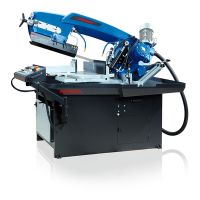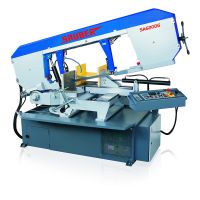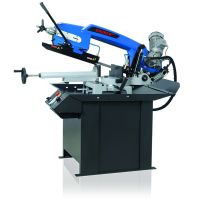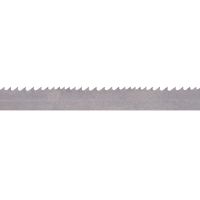There are lots of reasons a metal cutting bandsaw blade can lose teeth, but for this article we’ll detail the main ones which we find cover perhaps 90% of the situations we come across in the field. Briefly summarised, they are:
- Too many teeth in the cut
- Not enough teeth in the cut
- Blade run-in procedure
- Feed rate
- Tooth geometry
Let’s take a deeper dive into each one of these factors:
Too many teeth in the cut
We find most operators understand that having too coarse a blade for the section size will potentially snag a tooth on a thin wall or similar, potentially ripping off teeth. Less well known is that the reverse is just as hard on a blade. This is because as each tooth removes material (swarf), that material is stored in the tooth gullets where it is unable to escape until it reaches the other side of the cut. As the blade penetrates further into the material, those gullets get packed fuller & tighter… and if the pressure gets too great before the gullet can discharge its load on the other side of the cut, something gives – and usually that will be the most fragile part of the blade, i.e. the tooth point.
Try to stick to the rule of at least 3 teeth in the cut, but no more than 20. If you can’t achieve that, the answer is to reduce your feed rate to slow down the build-up in the tooth gullets.
Not enough teeth in the cut
This one is nearly a no-brainer, but we’ll say it anyway: if you have a blade with too few teeth for the material you’re trying to cut, you run the risk of catching that tooth on the material and ripping it off. Once one tooth is gone, the next tooth has to do double the work, and chances are it will soon follow suit!
Once again aim for a blade which will give at least 3 teeth in the cut. In compromise situations where this is difficult to achieve, reducing the feed rate lowers the risk of snagging those teeth. Increasing the band speed where possible also gives the effect of more teeth in the cut, but check the maximum blade speed parameters for your material first!
Not sure if your problem is too many, or too few teeth in the cut? On a variable tooth pitch blade, look at which teeth are being damaged first. If it is the large teeth, chances are you need a finer blade, if it is the small teeth, you probably want a coarser blade.
Blade run-in procedure
When is a blade at its most fragile? When it is brand new! The best analogy we know to a sharp new tooth and how it should be treated, is to that of a freshly sharpened pencil. As with the sharpened pencil, if you start using a new blade like you finished using the old one, you risk damaging the tooth points. This is because the delicate points on those new teeth are so keen, they bite into the material very easily so are more prone to catching, and tearing the teeth off.
So, go easy. For a new blade, reduce your feed rate to about half the usual for the first half hour of cutting time, ramping it up to normal over the next half hour.
If possible, the run-in period should be on close-to-ideal sized material for the given tooth pitch, say 10 teeth in the cut. That isn’t always possible, in which case just take extra care. But it is a fact that once a blade is run in, you are more likely to be able to successfully use it even beyond the recommended material sizes for its tooth pitch.
Feed rates
What feed rate should I use on my bandsaw? Well, how long is a piece of string?! In this case, the length of string is the length of the swarf/chips.
On mild steel we aim for 6’s and 9’s, in other words short curls of material. If the swarf is long and stringy, the feed rate is probably too heavy. If the swarf looks sandy, the feed rate is too light. Too heavy a feed rate and the tooth just may not cope with the stress. Too light, and you run the risk of rubbing rather than penetrating the material, leading to workpiece hardening and blunt teeth.
Different materials have different feed rates, generally harder materials will be slower, and softer will be faster. A lot will come down to the operator’s intuition, and you want to get as much cutting out of a blade before it inevitably fatigues and breaks. So, as perverse as it sounds one reasonable method of determining the ideal feed rate is to crank it up until you start breaking teeth, then back it off a little thereafter.
We have comprehensive speed and feed charts available to cover a range of different materials.
Tooth geometry
Modern blade developments mean there is now a wider choice of tooth shapes to cope with difficult sawing situations. This is especially true where users find the rule ‘minimum of 3 teeth, maximum of 22 teeth’ almost impossible to adhere to – structural steel often falls into this category, as do many other applications cutting pipe, hollow sections and angle iron.
For these users we often recommend a ‘structural’ tooth blade style, which has a lower, much stronger tooth shape which is far superior at handling the wide range of teeth engaged in the cut.
Other reasons blades lose teeth
If you have got all the above points nailed down and are still having problems with tooth strippage, there are a number of less common possible causes, as follows:
- Foreign material interference
- Material clamping & positioning
- Blade jamming
- Band tension
- Band speed
- Machine & maintenance issues
- Blade quality
If you need specific help, please reach out to one of the team on customercare@wolfmach.com, or give us a call!




